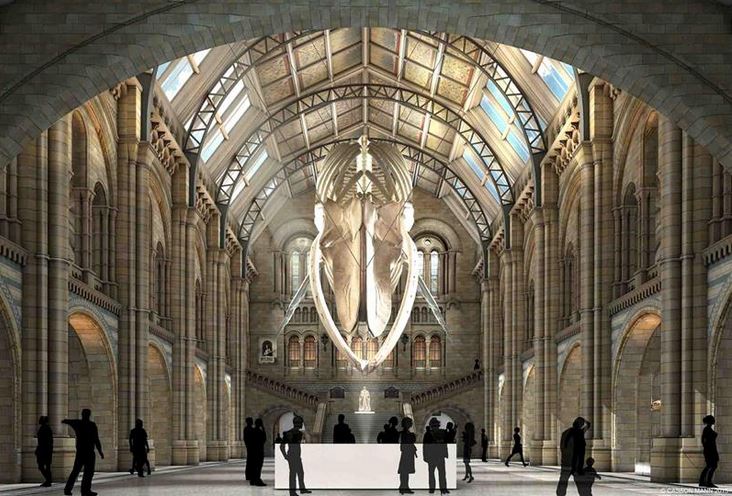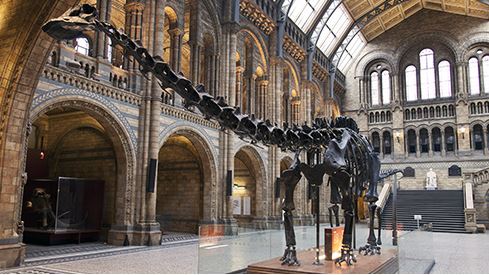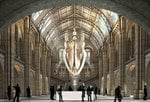The cast of Dippy the Diplodocus dinosaur that has stood in Hintze Hall, at the main entrance of London’s Natural History Museum for the last 35 years, will be replaced by a vast blue whale skeleton in 2017.
The decision to suspend the skeleton of the blue whale from the ceiling is part of a larger plan to display new specimens in Hintze Hall, the museum announced on Thursday.
The new displays will “tell the story of our connection with the natural world through the Museum’s unique collections and research,” the 134-year-old museum explained.

The vast skeleton of a blue whale will be suspended dynamically from the ceiling and plunging through the iconic space, it will take on the role held by the much-loved Dippy for 35 years. (Image: London’s Natural History Museum)
It was felt that the blue whale skeleton would give an immediate and impactful introduction to visitors, one that illustrates the Museum’s research into the rich biodiversity of Earth and a sustainable future, as well as the evolution and origins of life.
The Museum is considering taking the iconic Diplodocus cast, affectionately known as Dippy, on tour so that more people can enjoy it.
Director of the Museum, Sir Michael Dixon, said:
“As the largest known animal to have ever lived on Earth, the story of the blue whale reminds us of the scale of our responsibility to the planet.”
“This makes it the perfect choice of specimen to welcome and capture the imagination of our visitors, as well as marking a major transformation of the Museum.”
From Central Hall to Hintze Hall
Hintze Hall, formerly called the Central Hall, changed its name in May 2014 in recognition of a ₤5 million donation from British-Australian businessman and philanthropist Sir Michael Hintze to the museum. It was the largest single donation the Museum ever received.

Dippy the Diplodocus dinosaur will go on tour, the Museum says. (Image: London’s Natural History Museum)
The Museum says it plans to change how the collection is developed and displaced in Hintze Hall for future generations. It will also change how it creates and shares its scientific research “so that engaging with the natural world is a part of everyone’s lives.”
The whale was found in Wexford Harbour, Ireland, in 1891 beached and injured by whalers. It was brought to the Museum and initially went on display in the Mammal Hall in 1938, where it currently hangs above a life-size blue whale model.
During the first half of the 20th century, the population of blue whales plummeted following the popularity of whaling. However, since gaining protected status in the 1960s its numbers have started to recover.
The whale is Earth’s largest ever animal, and has a fascinating history “from sea to land and back again,” the Museum says.
Sir Dixon said:
“This is an important and necessary change. As guardians of one of the world’s greatest scientific resources, our purpose is to challenge the way people think about the natural world, and that goal has never been more urgent.”
“The blue whale serves as a poignant reminder that while abundance is no guarantee of survival, through our choices, we can make a real difference.”

